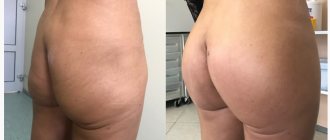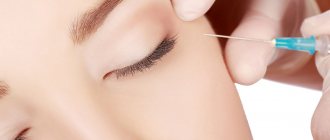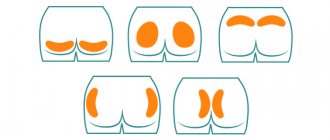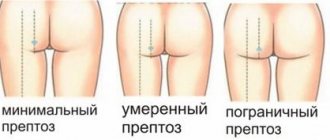Firm, rounded buttocks are an attractive part of the body for a person of any gender and age. You can deny this fact as much as you like, but animal instincts will always force us to pay attention to this “detail” of our own and others’ figures.
Everyone has different tastes. Some people like “butts like a nut”, others like round and soft ones. In recent years, there has even been a certain cult of buttocks - spherical and hard, like bowling shells. To achieve this ideal, people, especially women, are willing to literally live in gyms.
However, not everyone can train fiercely for months to achieve the perfect body. And it’s not always possible to pump up your “dream butt” with squats. If by nature a person is given one shape of buttocks, but he dreams of a completely different one, the situation cannot be corrected without outside intervention.
In such a situation, only surgery can help - buttock plastic .
1
Consultation with a plastic surgeon
2 Plastic surgery for buttock correction
3 Plastic surgery for buttock correction
Why is buttock surgery performed?
The roundness and elevation of the buttocks are ensured by dozens of muscles and ligaments, not only the gluteal ones, but also partly the femoral ones. Over the years, the muscles in this area sag, resulting in a deterioration in shape and volume. The situation can be corrected surgically.
The buttock lift procedure helps eliminate sagging soft tissues and correct cosmetic skin defects. However, if the goal is to reshape and add volume to flat buttocks, a more radical operation called gluteoplasty . The essence of this surgical intervention is the correction of the buttocks using silicone implants.
Indications for buttock surgery:
- scars, stretch marks and other skin defects of the buttocks;
- loss of volume, ptosis of soft tissues, sagging skin in the area;
- congenital or acquired asymmetry and deformation of the buttocks;
- flat buttocks, unaesthetic shape of the buttocks.
Preparation for surgical correction of the buttocks
You should start preparing with a consultation with a plastic surgeon. After conducting an examination, the doctor will listen to the patient’s complaints and wishes, make suggestions on the surgical technique, and report on the method of anesthesia.
Next, you need to undergo preoperative diagnostics. This is a mandatory step for every surgical procedure and allows you to identify health problems that may interfere with surgery.
The list of contraindications to buttock surgery includes:
- malignant processes;
- diabetes;
- heart and vascular diseases;
- bleeding disorders;
- infections of various origins;
- pregnancy, lactation, etc.
Types of buttock surgery
The method of correction of the buttocks is determined in accordance with the task, the volume of impact, and the physical parameters of the patient.
There are several ways:
- buttock lift (without endoprosthetics).
- gluteoplasty (shape correction, buttock augmentation with implants;
- thread correction of the buttocks.
Surgical butt lift
There is no universal surgical access for plastic surgery of the gluteal region. The incision area is determined by the purpose of the intervention. So, to correct drooping, long, asymmetrical buttocks, a median (medial) or lower incision is made. For trochanteric sagging, it is more effective to use a lateral or superior incision (Pascal's incision).
Through the incision, the plastic surgeon excises excess soft tissue, tightens and fixes the muscles, then closes the incision area with cosmetic sutures. If necessary, the lifting procedure can be performed simultaneously with liposuction or with surgery on the outer or inner thighs (buttock and thigh lift).
The operation is performed under general or local anesthesia for 2-2.5 hours.
A butt lift provides a significant rejuvenation effect in a given area, maintaining the result for 10 years or more (in the absence of weight fluctuations). However, the method also has significant disadvantages: long recovery, postoperative scars, for example, the inability to correct the shape of flat or severely drooping buttocks.
Buttock surgery. Photo before:
1 Before buttock surgery
2 Before buttock surgery
3 Before buttock surgery
Buttock surgery. Photo after:
1 After buttock surgery
2 After buttock surgery
3 After buttock surgery
Buttock enlargement
The gluteoplasty technique involves the use of silicone implants. They are round, oval and teardrop-shaped (anatomical). Round and oval endoprostheses are well suited for enlarging the buttocks and giving them roundness. Anatomical implants are chosen when it is necessary to correct aesthetic defects (asymmetry, deformation of the buttocks).
The implant is installed through a small incision in the sacral area in the natural intergluteal fold. The endoprosthesis is placed under the muscle that holds it and does not allow it to move along the buttock, or under the superficial gluteal fascia to ensure maximum naturalness. Buttock surgery is often combined with liposuction and hip correction (this technique is also called body lift).
After placing the endoprostheses, the surgeon places cosmetic sutures on the incisions (usually self-absorbable material is used) and, if necessary, installs drainage.
The operation takes about 1.5-2 hours and is done under general anesthesia.
Buttock lift with threads
A thread lift, often called a Brazilian lift, is used in cases of slight ptosis of soft tissues and skin and in the presence of cellulite.
Through micropunctures, threads are placed under the skin using cannulas, which are fixed in the soft tissues using special notches or cones. After installing the threads, the surgeon tightens the soft tissue to them and secures them in a new position. If necessary, a thread lift is combined with lipofilling or liposuction.
The intervention is performed under local anesthesia for 1 hour.
The advantages of the method include quick rehabilitation and the absence of scars. The disadvantages are the short duration of the effect (from 3 to 5 years).
Will fitness help? Ptosis of the buttocks.
The appearance of the buttocks directly depends on the thickness, evenness and smoothness of the fat layer that lies under the skin.
With age, under the influence of many unfavorable factors, the fat layer and the skin above it undergoes a number of changes and transformations: it goes down, increases or decreases in size.
Among the unfavorable factors are:
- sedentary lifestyle, lack of physical activity;
- bad habits;
- sudden weight fluctuations;
- natural gravity, gravity.
As a result, the buttocks sag. In medicine, this phenomenon is called ptosis.
Ptosis is a drooping of the soft tissues (adipose tissue, collagen components, skin) located on the surface of the gluteal muscles, above the subgluteal ligament, which is the bridge between the buttock and the thigh.
Ptosis is easily diagnosed by its appearance: the center of the buttocks shifts downward, and a clearly defined subgluteal fold appears. In addition, the presence of ptosis is well determined by the appearance of the buttocks in profile.
There are several stages and degrees of buttock ptosis:
In the absence of ptosis, the gluteal fold is not visible or may reach the line of the ischial tuberosity, and the angle formed between the overhanging buttock and the thigh should not be more than 90 degrees.
Let's look at the stages of ptosis.
1. Minimal preptosis
With minimal preptosis, the gluteal fold crosses the line of the ischial tuberosity without reaching the midline of the thigh.
2. Moderate preptosis
When the gluteal fold reaches the midline of the thigh without crossing it, moderate preptosis is said to be present.
3. Borderline preptosis
If the gluteal fold crosses the midline of the thigh, then we are dealing with borderline preptosis.
4. True ptosis of the buttocks
We speak of true ptosis when there is a pronounced gluteal fold that crosses the midline of the thigh at a considerable distance.
Degrees of ptosis
The degree of ptosis of the buttocks is determined using a ruler.
First degree
With the first degree of ptosis, the gluteal fold descends by about 5 cm of the subgluteal groove;
Second degree
With the second degree of ptosis, the gluteal fold drops 1 cm below the subgluteal groove;
Third degree
With the third degree of ptosis, the gluteal fold drops 2 or more centimeters below the groove under the buttocks.
Ptosis can even occur in athletes. By pumping up your pelvic muscles, you increase their weight and size. Weight makes the fold more pronounced.
Thus, buttock ptosis cannot be corrected in the gym. Only aesthetic medicine can solve this problem.
After buttock surgery
After surgical correction of the buttocks, pain and decreased sensitivity may persist in the intervention area for 2-3 days. No sitting is allowed for at least 7 days.
After 14 days, the patient can return to their normal lifestyle. However, you should refrain from physical exercise for at least 1.5 months. And it is recommended to wear special compression garments for at least the same amount of time.
MedicCity offers a full range of plastic surgeries and cosmetic procedures for the face and body. Our plastic surgeons are recognized masters of their craft, professionals of the highest class! The cost is average in Moscow. If you are choosing a specialist to whom you want to entrust the correction of your buttocks, read reviews of the clinic’s plastic surgeons.
Small buttocks
The operation to enlarge small buttocks in plastic surgery is called gluteoplasty and is performed mainly for aesthetic reasons and in case of inability to “pump up” the muscles of the buttocks. Plastic surgery can be performed on both women and men of almost any age.
Gluteoplasty is used:
- to increase or restore the volume of the buttocks (for example, with small buttocks or after sudden weight loss),
- to eliminate buttock asymmetry (with unilateral tissue atrophy or buttock injury)
- to improve the shape and contour of the buttocks (with an android pelvis).
Correction of small buttocks during gluteoplasty is achieved by endoprosthetics - one of the most effective and safe methods. Special durable, sealed silicone implants are used - endoprostheses, which increase volume and create a remarkable aesthetic effect. Gluteal muscle implants are biocompatible with body tissues; the shell covering them is made of environmentally friendly, chemically inert material - silicone elastomer. In terms of their density and physical properties, implants do not differ from muscle tissue; they provide natural softness and safety thanks to the highly cohesive gel located inside them. The implants can withstand intense loads, are resistant to external damage (the gel does not migrate even if the integrity of the outer shell is damaged), have a lifetime guarantee and do not require replacement. The textured surface of the implant reduces the risk of fibrosis - thickening and hardening of the tissue of the buttocks.
The anatomical shape and size of the implant is selected by the doctor in advance depending on the patient’s figure. Implants come in round and oval shapes. The use of implants makes it possible to give the missing volume to flat and small buttocks, improve their shape and give this part of the body aesthetics and attractiveness.
Buttock augmentation surgery is performed under general anesthesia and lasts about 2 hours. Gluteoplasty is often performed through one small incision (5–6 cm) in the intergluteal fold, which makes the postoperative scar almost invisible. The silicone implant is usually placed under the gluteus maximus muscle in a pre-formed pocket. The location of the implant depends on the patient’s body structure and the surgeon’s recommendations. The tissue of the buttocks above the implant is restored using cosmetic sutures. Implants are also sometimes installed under fatty tissue, usually in the upper part of the buttocks. There may be slight discomfort and soreness for several days. The duration of the rehabilitation period is 1.5 months (4 -6 weeks).
During this time, physical activity is limited (you cannot jump, do some exercises, or take a steam bath). The correct position of the implant after surgery is ensured due to the elasticity of the tissues of the buttocks, but it is additionally required to wear special compression garments for 1.5 - 2 months to promote the formation of “new” buttocks. After the operation, the implants become completely invisible and do not cause any sensation when walking or sitting. After gluteoplasty, injections into the buttock area are strictly prohibited; throughout life, injections are allowed only in the thigh area.
An increase in the volume of small buttocks can also be achieved using lipofilling (fat grafting). When fat grafting occurs, the patient’s own fat cells are introduced into the gluteal region. Fat grafting makes it possible to achieve a double aesthetic effect: in the buttocks area – an increase in volume, and in places of excess fat deposits (on the sides, abdomen) – a decrease in volume due to the removal of adipose tissue.










